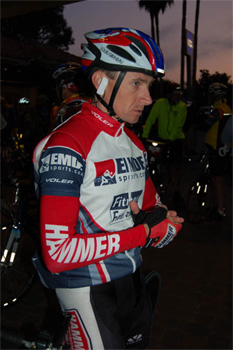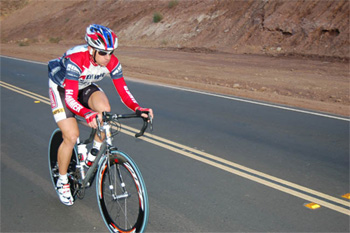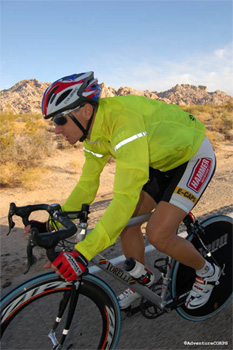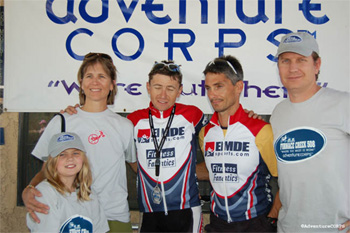
Alpine Ibex's 2006 Furnace Creek 508
By crew member Robert Treadwell
Twenty eight hours, twenty three minutes and thirty one seconds after he crossed the start line in Santa Clarita California Michael Emde had to be helped off his bicycle. The Men's solo division winner of the 2006 Furnace Creek Ultra Endurance race couldn't lift his leg over the saddle. Every ounce of physical energy he had possessed was spread across the 508.5 mile course. The few spectators at the finish line in Twentynine Palms California were witness to this culmination of willpower and determination. Most didn't know, but a crash with approximately 328 miles to go in the race had also taken its toll. Dried blood caked Emde's right side and he could no longer feel his feet. Sweat formed crystalline white outlines on his face, and yet Emde smiled as he was lowered into a chair that gave him his first opportunity to relax in over a day.
Everything about the "Furnace Creek 508" is big, really big. Race organizer Chris Kostman tells the athletes prior to the start, "Don't think about the 508 miles of bad roads, the 35,000 feet of climbing, and the thermonuclear headwinds into the finish." I was lucky enough to be there and see these things as one of Emde's crew members.
No one does Furnace Creek alone. The riders require a team of individuals to support their monumental effort. Emde's team consists of three including myself, Emde's wife Marla and his daughter Martina. Marla and Michael have a successful athlete coaching and event promotion business. They are no strangers to preparing athletes for competition. The special requirements of Furnace Creek make that expertise extremely valuable. Marla carefully plans and notates every calorie that Michael ingests during the race. Keeping an athlete physically and mentally strong for such an extended period takes serious commitment and some tough and tender love. Having his wife and daughter along was a tremendous boost. Emde continually states that, "…the team has the hard job; I just have to ride the bicycle."
Michael Emde is originally from Vienna Austria. He moved to the United States after having met is wife in the competitive world of bicycle racing. His busy schedule often dictates that his training takes place at odd hours. Riding into the night is not unusual for Emde.
"There's a ten mile loop I ride that takes me past a tavern in a small town where I often ride at night, you see some interesting things at 1:00 am," explained Emde, "…quite different from the 508."
The Furnace Creek 508 was created in 1983. It was originally held on a 102 mile loop around Hemet California. It moved to Arizona between Flagstaff and Tucson before settling into the California desert. Part of the appeal of the race is its location. The race bills itself as "The toughest 48 hours in sport" so it is appropriate that it is now held in one of the toughest places on earth: Death Valley. Participants have 48 hours to complete what many consider a spiritual odyssey as well as a test of athletic endurance.
While Emde truly believes that everyone's primary goal should be to finish the epic race, for the 2006 edition, he harbored somewhat greater aspirations. In what would be his second Furnace Creek Emde hoped to improve upon the 3rd place finish from 2005. Despite a mechanical malfunction that cost him about 30 minutes that year, Emde's time was still fast enough to set the record in his 30 to 39 year old age group.
"My first goal is to finish. This race is too long, and too many things can happen to plan much beyond that," says Emde. "After that though, like two spaces down, it's my goal to finish top three." Beyond that, well, Emde will just admit that he'd like to break his personal record.
The race officially begins in Santa Clarita California, at the Hilton Hotel. As the riders leave the start line at 7:00 am the team vehicles make their way to a designated rendezvous point. Safety concerns due to the sheer number of vehicles dictate that the initial 24.6 miles of the race must be navigated by the riders alone. Only once the riders begin to spread out can the team cars begin the initial rider support in a "leap-frog" fashion.
Emde arrived at the rendezvous point first, and while he would never relinquish that lead, many tense and exciting moments were yet to follow. Upon initially studying the race roster of participants, Emde had noticed the name of Mike Trevino, a well-known ultra endurance athlete. Racers are required to choose an animal name as their "Totem." The Totem is used to identify the racers, and may offer a clue into their personalities. Mike Trevino is "Snow Leopard" and Michael Emde is "Alpine Ibex." Those two totems would battle for the next few hours.
Initially, the team cars for the Ibex and the Leopard shared the road and its shoulder, pulling over together to continually keep an eye on their respective riders. A mechanical problem like a flat tire would cause a significant delay if the team car is out of sight and unable to respond with a spare wheel. Handing a water bottle to a streaking rider takes a little practice. The technique involves holding the bottle loosely while trying to run slowly along the shoulder. The key is to let the rider take it, rather than actually hand it to them. I missed only once. As time passed quickly, the Ibex began to open a lead, and the Snow Leopard car was soon out of sight.
With his lead continuing to grow slowly as the miles ticked by Emde faced what might be the ultimate challenge of the race. With one hand on the bicycle's bars, and the other clutching the race radio, an unexpected rut in the road wrenched away his control of the bike at 30 miles per hour.
"I reached for the bar," says Emde, "but it just happened too fast. I thought I might steer it out…and then I was on the deck. I remember yelling that I was crashing into the microphone."

The team car came around the sweeping corner as Emde quickly sprang to his feet. A collective gasp escaped as we struggled to get the vehicle stopped and check out Emde's condition. As his wife tried to administer first aid Emde simply asked for his spare bicycle. The blood was dripping steadily from his elbow, and the palms of his gloves were shredded clean through. The right side of the Emde Sports Jersey hung in shreds, and his shin began to ooze where the asphalt had rendered it raw. It took only a few moments for me to grab the other bicycle from the van's roof. Emde was right there to help secure the front wheel into the forks. While his crew looked on, he clipped into the pedal and was off.
"I knew it was wasting valuable time, and I knew that I might begin to stiffen up if I waited too long," said Emde. "On the bike I knew really quickly that things might be hard, my hip flexors were hurting as I tried to stand up on the pedals. I told my crew this on the radio."
In the van, we watched as Alpine Ibex worked his legs, trying to stretch his sore muscles. He knew that he still had about two thirds of the race to go, and that the toughest climbs were yet to come. A crash that may have served as a perfectly legitimate excuse to abandon the race only served to strengthen Emde's resolve. His wife and daughter looked on with equal measure of concern and pride.
"I knew he was tough…" said wife Marla at the finish, "but that was unbelievable."
"No matter what happened," Emde said later, "I came here to finish the race."
The first real test after the crash would be 4,956 foot Towne's pass. It is said that the numerous lights of the team vehicles edging up the 10 mile climb at night is an awesome sight. I wouldn't know. One of Emde's goals was to traverse the steep incline during daylight. He was the only rider to meet that goal. After riding nearly 200 miles, Towne's pass forces the rider to negotiate a climb that averages 6-10% and peaks at as much as 13%. It serves as the gateway out of the Panamint valley and the entrance into the descent to Death Valley.
Eleven hours into the race at 6:00 pm "night" is officially declared by the race staff. Team vehicles must display roof mounted flashing lights and a slow moving vehicle warning sign. From this point, until the finish, we would become Emde's rolling shadow. The van would be there to offer crucial light for the coming miles and provide some shelter from approaching vehicles. Tired drivers might not otherwise see a small figure on a bicycle in the vast expanse of the dark Death Valley desert. The descent into the valley poses some significant risk. Emde is a confident descender, his speed is only checked by the van's ability to light his way. The road twists but a little, but the dips in its surface send the van's headlights skyward temporarily obscuring the crumbling road surface.
"I had to slow down a little, because I knew the van couldn't keep up. I figured if I outran the lights, I could go toward the center line of the road. I wanted to stay away from the shoulder as best I could," explained Emde.
The traverse through Death Valley was beautifully surreal under an almost full moon. Few races feature scorpions as road hazards, but their shadows danced from the headlight as Emde adjusted his line to miss them. Having a scorpion strike a tire and travel around its arc could result in the poisonous creature being flung onto his legs. The previous year, a stray jackrabbit had actually run across the road in front of him, and even with Emde's best efforts to avoid it, the poor creature thumped under the bicycle's rear tire. The road surface is not too bad by 508 standards, but after twelve hours in the saddle, concentration has to be maintained to avoid another accident. A second crash could almost certainly cause disaster.
Some of the lighter moments of the race came in Death Valley. In the darkness we spotted a vehicle stopped on the opposite shoulder of the road. As we approached we could see a road map spread over the steering wheel of the car. A wide-eyed tourist let his jaw slip as he saw the well-lit caravan of bicycle and van cross his path. What he thought, on that lonely stretch of deserted road in the seeming middle of nowhere, I can only guess. In certain areas of the vast emptiness of the California desert it is permissible to play music for the rider over a vehicle mounted public address system. Appropriately, Bon Jovi's "I'm a cowboy, on a steel horse I ride…" lifted Emde's cadence to its beat. A few moments of critical musical reviews followed as Marla and I discussed Emde's choices of music that ranged from Madonna to German heavy metal.
For most riders, a few extra minutes here and there might barely merit attention, but Emde began to realize that victory could be his. The 508 offers too many obstacles and potential problems for an athlete ever to feel really safe. Somewhere in the night the team began to get unofficial time splits. Word came that Alpine Ibex had achieved a twenty minute lead over the Snow Leopard.
"Twenty minutes is nothing!" exclaimed Emde. "That could be wiped out quickly if we have a problem."
The crash had altered Emde's strategy in another crucial way. Like most riders, Emde had counted on the increased aerodynamics of his time trial bicycle to offer some additional speed. A time trial bike allows the rider to sit lower, and in a more streamlined position with his arms tucked in tight in front of him. The crash had ripped his elbow and forearm, and it put stresses on his body to the point where adopting this position would be impossible. He knew that his competition faced no such problem. Valuable time could be lost to his opponent's advantage.

"We need to make the Baker stop as quickly as possible," breathed Emde to me as I made a window exchange of a nutrient rich water bottle. The crew in the van organized a plan to fuel both the vehicle, and the rider in as fast a time as possible. I grabbed an empty gallon water jug, climbed over the seat and found an uncomfortable spot wedged between an ice chest, the van's roof and some boxes where I could relieve myself for the first time since the race began. I haven't done that since traveling with my grandfather as a kid. As I climbed back to the front seat from my makeshift latrine Marla just shook her head, smiled, and said simply: "Excellent!" At 3:00 am our thoughts were beginning to jumble, but it was clear that getting the gas into the vehicle required one member, and swapping bottles and tending the rider's needs another. There would be no time for me to hit the gas station's "nice clean restroom." The previous year, Emde suffered stomach distress and had to spend numerous minutes in that gas station's rest-room. That stop was estimated to have taken 20 minutes. This year would be different, this year the stop took less than five minutes.
The climb outside of Baker California is long, 21.4 miles and it comes after 384 miles. Looking back down the long slope Emde could see the competition for the first time in many hours. The flashing amber lights of team cars could just be seen in the distance. No one on the Alpine Ibex team knew just who was back there. The stress level increased with each pedal stroke, time checks were unofficial and at best only estimates. The pavement began to worsen, and the climb began to get steeper. Emde was concerned that Snow Leopard had made up some time with his time trial bike on the flat miles through Death Valley. Emde knew his strength was in the climbs, and he decided to press that advantage. In the van we knew Emde's pace up that climb would be unmatchable. He would increase his lead.
The headlights of the van illuminated the river-rock-like surface of potholes and cracks that substituted for a road. In the small hours of Sunday morning Emde maneuvered the bicycle back and forth across the lane looking for a smooth surface. He hoped to ease the shock coming up through the bars pounding his tired body as he crested the summit. The descent into the tiny desert town of Kelso California came as the sun began to lighten the eastern sky. The pink clouds and deep blue sky proceeding the sunrise provided a welcome psychological boost and the bright Sunlight would soon warm Emde's body as it struggled up the next climb of 12 miles.
Emde motioned the van forward to pass off his amber lensed glasses. As he removed them from his head both Marla and I saw his puffy red rimmed eyes. The rough pavement had forced him into a continual squint from the concentration of climbing and descending during past night's hours. Marla and I were shocked at the transformation from only a few hours before. Emde had been on the bicycle for nearly 24 hours, and the strain had begun to show in earnest. With a few quick words of encouragement from his crew he donned the darker Axley sunglasses, stood on the pedals and propelled the bicycle toward the summit.
Cresting the climb before the long decent into the outskirts of Amboy California photographers from the race promoting Adventure Corps began staking out opportune vantages to fill their lenses with the race leader's image. It was at this time that the news was given to Team Alpine Ibex that the lead earned on the climbs had been stretched to over an hour. Emde would still not allow himself to be complacent, and he pushed himself even harder. Most people never really learn their limits. Today's world of comfort and convenience offers most people a safe and easy experience day-in and day-out. The 508 is miles away, both literally and figuratively, from that everyday and Michael Emde is not most people.
The low point came a few miles beyond the environs of Amboy. The final climb of the race begins fairly gradually but steepens increasingly over its ten mile run. A few miles before the summit that marks the final 28.1 miles to the finish, Emde motioned the van forward.

"I'm empty," he said. It was not a complaint; it was a simple statement of fact uttered without emotion, without regret, without excuse. He looked to his family, to the team that had traveled almost fifteen hundred miles from Spokane Washington to be there with him. He heard the words of encouragement; he saw the tired faces of his wife, his daughter and his friend. He reached into his pocket, took a hard pull of Hammer gel from his flask and then he reached deep down into his gut, into the well of determination and confidence that got him there. He reached down into the competitive spirit of 20 years of racing, training and suffering, and he turned his head toward the summit and stood on the pedals one more time.
In my opinion, that's where the race truly became Emde's.
There is no fanfare at the finish of the 508, no podium girls, no big fake checks to hold up. They take your picture, and they hang a really nice medal around your neck. Finishing the race, finding out who you are and what you're made of is reward enough for everyone. Winning is sweet and Emde plans on riding the 508 again next year as defending champion. His goal will be to once again finish the epic odyssey.
Not everyone of the approximately 180 solo and team riders who began the race that Saturday morning made it to the finish line. Everyone who entered has a story and a memory, and those that made it; each has a finisher's medal just like Michael Emde's.